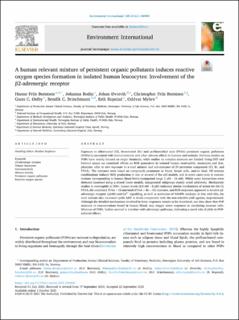A human relevant mixture of persistent organic pollutants induces reactive oxygen species formation in isolated human leucocytes: Involvement of the β2-adrenergic receptor
Berntsen, Hanne Friis; Bodin, Johanna Eva; Øvrevik, Johan; Berntsen, Christopher Friis; Østby, Gunn Charlotte; Brinchmann, Bendik Christian; Ropstad, Erik; Myhre, Oddvar
Peer reviewed, Journal article
Published version
Permanent lenke
https://hdl.handle.net/11250/3009368Utgivelsesdato
2021Metadata
Vis full innførselSamlinger
- Artikler [5068]
- Publikasjoner fra CRIStin FHI [7544]
Sammendrag
Exposure to chlorinated (Cl), brominated (Br) and perfluoroalkyl acid (PFAA) persistent organic pollutants (POPs) is associated with immunotoxicity and other adverse effects in humans and animals. Previous studies on POPs have mainly focused on single chemicals, while studies on complex mixtures are limited. Using DCF and luminol assays we examined effects on ROS generation in isolated human neutrophils, monocytes and lymphocytes, after in vitro exposure to a total mixture and sub-mixtures of 29 persistent compounds (Cl, Br, and PFAA). The mixtures were based on compounds prominent in blood, breast milk, and/or food. All mixture combinations induced ROS production in one or several of the cell models, and in some cases even at concentrations corresponding to human blood levels (compound range 1 pM – 16 nM). Whilst some interactions were detected (assessed using a mixed linear model), halogenated subgroups mainly acted additively. Mechanistic studies in neutrophils at 500× human levels (0.5 nM – 8 µM) indicated similar mechanisms of action for the Cl, PFAA, the combined PFAA + Cl and total (PFAA + Br + Cl) mixtures, and ROS responses appeared to involve β2-adrenergic receptor (β2AR) and Ca2+ signalling, as well as activation of NADPH oxidases. In line with this, the total mixture also increased cyclic AMP at levels comparable with the non-selective βAR agonist, isoproterenol. Although the detailed mechanisms involved in these responses remain to be elucidated, our data show that POP mixtures at concentrations found in human blood, may trigger stress responses in circulating immune cells. Mixtures of POPs, further seemed to interfere with adrenergic pathways, indicating a novel role of βARs in POP-induced effects.
